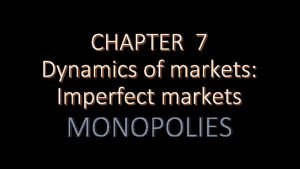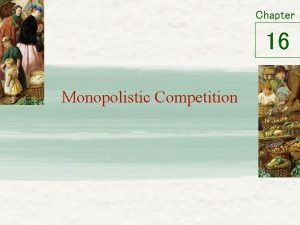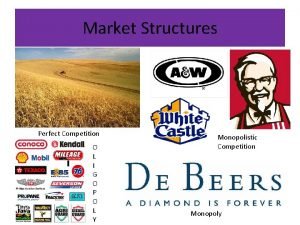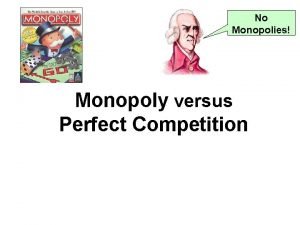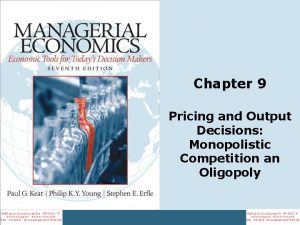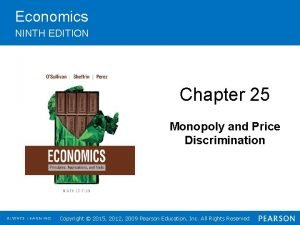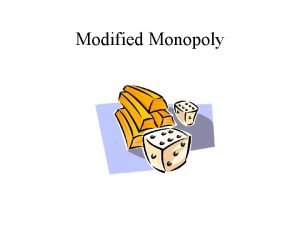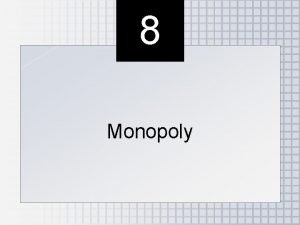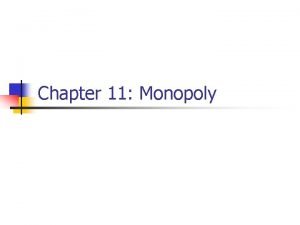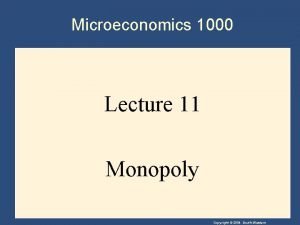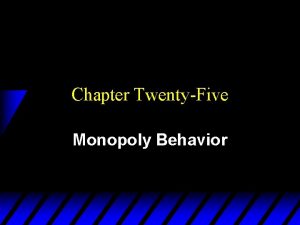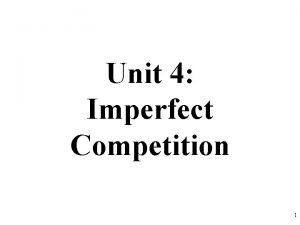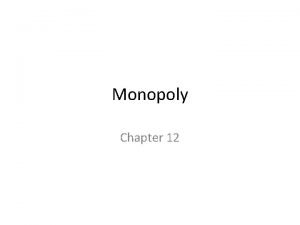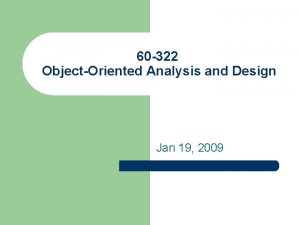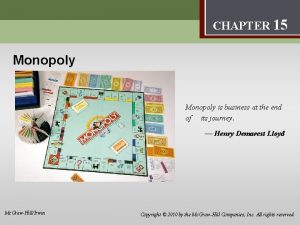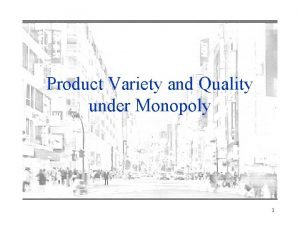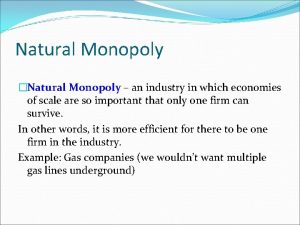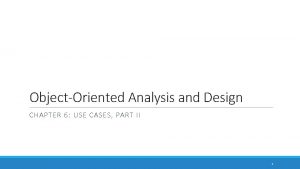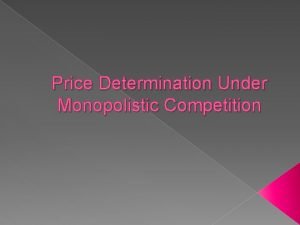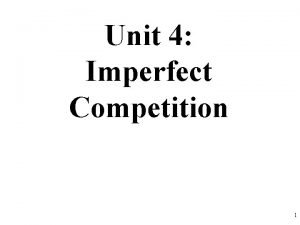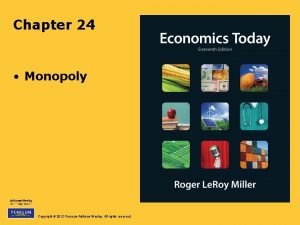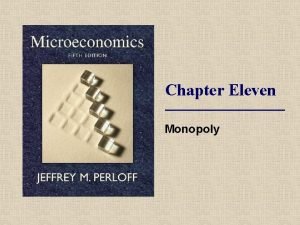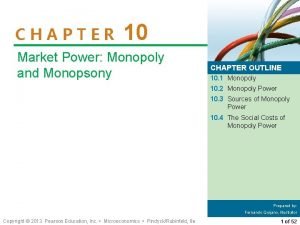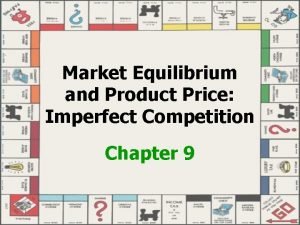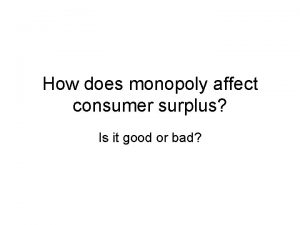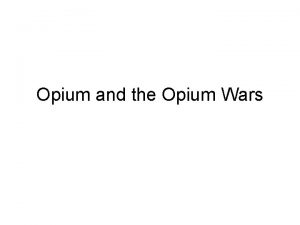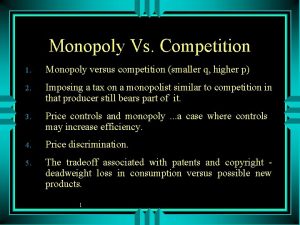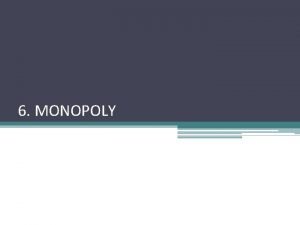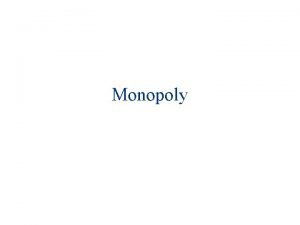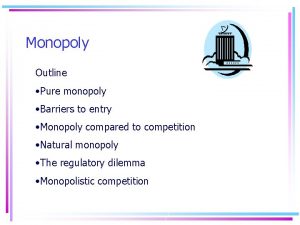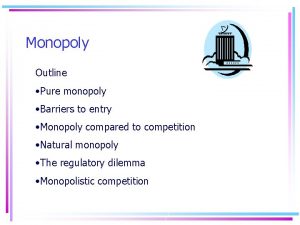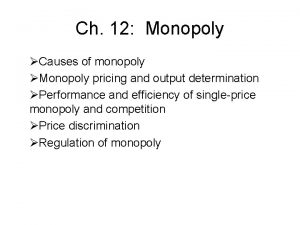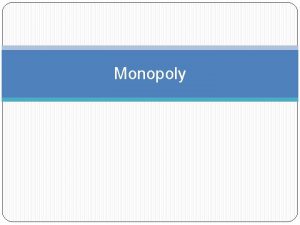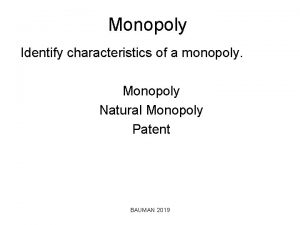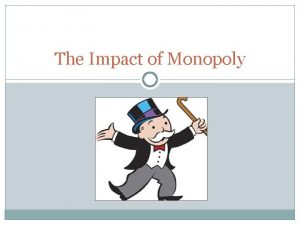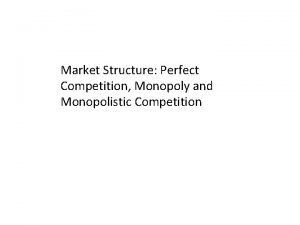I THEORIES OF COMPETITION MONOPOLY I THEORIES OF



































- Slides: 35

(I). THEORIES OF COMPETITION & MONOPOLY

� I� THEORIES OF COMPETITION & MONOPOLY ● PERFORMANCE VALUES ● FOUR TYPES OF ECONOMIC SYSTEM ● COMPETITION & PERFORMANCE

(I) THEORIES OF COMPETITION & MONOPOLY 0. Economics: Microeconomics Industrial Economics Scarcity: Efficiency, Economic Welfare Market Economy → Competition → Efficiency, Welfare

(I) THEORIES OF COMPETITION & MONOPOLY 1. PERFORMANCE VALUESScarcity, Efficiency, Welfare (1). Efficiency (2). R & D (3). Equity (4). Competition as a Value (5). Other Values

(I) THEORIES OF COMPETITION & MONOPOLY 2. Four Types of Economic Systems Adam Smith (1776) Resource Allocation The Wealth of Nations Private Market Command Market Capitalism Centrally Planned Capitalism Market Socialism Centrally Planned Socialism Resource Ownership State Karl Marx ( 1889) Capital

(I) THEORIES OF COMPETITION & MONOPOLY 3. Perfect Competition: An Invisible Hand? It involves pure competition plus certain strict assumptions, as follows: ( i ). perfect knowledge, ( ii ). perfect mobility, ( iii ). rational behavior ( iv ). market is clear ( v ). no nonmarket interdepenences. It is a “cartoon version” of effective competition. Price: the basic true measure of economic value.

� I� THEORIES OF COMPETITION & MONOPOLY 4. Competition & Performance 4 -(1). Efficiency -i. X-efficiency ( Internal Efficiency, Business Efficiency ) (1 -10% of costs)

� I� THEORIES OF COMPETITION & MONOPOLY 4. Competition & Performance 4 -(1). Efficiency -ii. Production Efficiency “Self-interest” Efficient Choices ↓ P=MR=LMC=Min. LAC

� I� THEORIES OF COMPETITION & MONOPOLY 4. Competition & Performance 4 -(1). Efficiency -iii. Allocative Efficiency: In an efficient general equilibrium, consumer surplus is maximized, an net total value can not be increased by any change. -iv. R&D : Technical Progress. The basic criterion: MR=MC.

� I� THEORIES OF COMPETITION & MONOPOLY 4. Competition & Performance 4 -(2). Equity: in distribution in 3 dimensions: wealth, income & opportunity. ◎ Fairness ◎ Ethical Criteria: equality, effort, contribution (productivity) & need. Traditional standards in the U. S. ( See p. 37 )

� I� THEORIES OF COMPETITION & MONOPOLY 4. Competition & Performance 4 -(3). Competition as a Value: It provides opportunities, freedom of choice, an outlet for talent, and incentives for superior performance. ( on a personal level, in the industrial arena ) 4 -(4). Other Values (a). Freedom of Choice (b). Security from Extreme Economic Risks (c). Good Content of Jobs (d ). Healthy Democracy (e). Cultural Richness & Diversity (37

(I) THEORIES OF COMPETITION & MONOPOLY 4. Competition & Performance 4 -(5). LIMITS -i. Product Differentiation ( eg. Monopolistic Competition ) -ii. Economies of Scale ( Natural Monopoly ) -iii. Innovation ( Market Power ) -iv. External Effects ( Market Failure ) -v. Public Goods ( Market Failure ) -vi. Inequality -vii. Insecurity and Risk -viii. Other Criteria

(I) THEORIES OF COMPETITION & MONOPOLY 5. The Monopolist’s Choices: Pure Monopoly -One seller controls all sales in the market. Pm>Pc Qm<Qc Pm>MC Consumer surplus (42)

(I) THEORIES OF COMPETITION & MONOPOLY 5 -(1). Monopoly’s Effects on Economic Performance -i. X-Inefficiency -ii. Misallocation: a reduction in consumer’s surplus. -iii. Redistribution: unfair income shift and wealth shift ? -iv. Invention and Innovation: less pressure, replacement effect -v. Freedom of choice: it is reduced for consumers, suppliers and workers(insecurity). -vi. Democracy -vii. Culture and Society

(I) THEORIES OF COMPETITION & MONOPOLY 5 -(1). Monopoly’s Effects on Economic Performance

(I) THEORIES OF COMPETITION & MONOPOLY 5 -(1). Effects of Monopoly Power on Economic Performance Combining the Effects of Monopoly

(I) THEORIES OF COMPETITION & MONOPOLY 6. Gradations of Market Power: there lie infinitely many gradations and varieties of markets. Combining Market Share and Other Elements: i. Market Share ii. Entry Barriers iii. Interaction among Oligopolists

( II ). INTRODUCTION

( II ). INTRODUCTION ● EFFECTIVE COMPETITION ● A PARADOX ● STRUCTURE , BEHAVIOR AND PERFORMANCE ● MARKET STRUCTURE: THE SIZE DISTRIBUTION OF FIRMS ● THE FIELD EVOLVES

( II ). INTRODUCTION 1. EFFECTIVE COMPETITION 1 -(1). Competition:

( II ). INTRODUCTION 1. EFFECTIVE COMPETITION 1 -(2). Effective Competition is the central concept of the field. It requires reasonable parity among numerous competitors, able to apply strong mutual pressure. (It is a matter of degree. ) (3)

( II ). INTRODUCTION 1. EFFECTIVE COMPETITION: 1 -(3). That usually requires -i. Internal Conditions: -a. Reasonable Parity among the competitors: No one firm should have more than a 40 percent market share and all five should at least 10 percent each. -b. Numerous enough to prevent effective collusion among them: At least 5 comparable competitors.

( II ). INTRODUCTION 1. EFFECTIVE COMPETITION: 1 -(3). That usually requires -ii. External Conditions: If the entry into the industry is easy , then the pressure from potential competition can reinforce effective competition.

( II ). INTRODUCTION 2. A PARADOX -(1). If Winning Causes Dominance, The Competition Is No longer Effective. -(2). To restore parity by limiting the new monopolist could be criticized as penalizing superior efficiency and destroying the incentive to succeed. ? ? ?

( II ). INTRODUCTION 2. A PARADOX -(3). In the sports world, competition is continually renewed and is usually effective, but only because there are elaborate rules and a remorseless aging process. (20) -(4). Antitrust Law

( II ). INTRODUCTION 3. The Austrian School - The Dynamic Process of Competition Schumpeter’s process of “Creative-Destruction” : Competition seems to be self-destructive. Schumpeter � 1950� Mueller� 1986� ( The Neoclassical Equilibrium Model )

( II ). INTRODUCTION 4. Structure , Behavior and Performance eg. Perfect Competition & Monopoly

( II ). INTRODUCTION 4. Structure , Behavior and Performance - Structure: Firm #, Firm Size, Concentration, Product Differentiation, Entry Conditions, Vertical Integration and Diversification… - Conduct: Policy Objectives, Pricing Objectives, Market Strategies and Research & Development, Collusion, Merger… - Performance: Efficiency, Profitability, Technical Progress…

( II ). INTRODUCTION 4. Structure , Behavior and Performance -(1). The Mainstream Hypothesis: Hypothesis Harvard School -i. S-C-P Analytical Structure -ii. Structure Generally Affects Performance (Structuralist) Structure → Market Power → Performance ( Efficiency etc. )

( II ). INTRODUCTION 4. Structure , Behavior and Performance -(2). Alternative: The New-Chicago School. ( Free Market Analysis ) -(3). Alternative: Free Entry by Potential Competitors. ( Contestability School ) -(4). Alternative: New Industrial Organization Theory

( II ). INTRODUCTION 4. Structure , Behavior and Performance -(2). Alternative: The New-Chicago School: ( Free Market Analysis ) They advanced the following four hypotheses 1. All monopoly merely reflects superior efficiency. 2. Therefore, all monopoly is virtuous and only collusion creates real market power. 3. But collusion always collapses quickly. 4. The costs of attaining monopoly commonly use up any possible monopoly profits in advance. ( IBM AT&T )

( II ). INTRODUCTION 4. Structure , Behavior and Performance -(3). Alternative: Free Entry by Potential Competitors. Contestability School – entry or exit is costless. Baumol et al � 1982� ( See p. 31 ) -(4). Alternative: New Industrial Organization Theory -(5). Transaction Cost Analysis – Coase � 1937� Williamson� 1971, 1975, 1979, 1985�

5. THE FIELD EVOLVES ● 1776 -1890 Classical School ● 1880 to 1910 Neoclassical Economics Modern Debates ● ● The 1930 s:Mason � 1939� The 1940 s and 1950 s: Mason� 1949� Bain� 1951, 1956, 1959� ● The 1960 s: Fudenberg & Tirole� 1989� ● 1970 to 1990:Schmalensee� 1988�

5. THE FIELD EVOLVES The 1990 s: a renewed focus on market share, Scherer on economies of scale, Williamson on transaction costs, Porter on competitive strategies, strategies ( 5 Forces Model) Ravenscraft, Mueller & Scherer on mergers, Shepherd’s assessment of the trend of Competition & many case studies.

 Difference between perfect competition and monopoly
Difference between perfect competition and monopoly Perfect competition vs monopolistic competition
Perfect competition vs monopolistic competition Difference perfect competition and monopoly
Difference perfect competition and monopoly Characteristic of monopoly
Characteristic of monopoly Difference between monopoly and monopolistic competition
Difference between monopoly and monopolistic competition Difference between perfect competition and monopoly
Difference between perfect competition and monopoly Pure competition and monopoly _____
Pure competition and monopoly _____ Oligopoly vs monopoly examples
Oligopoly vs monopoly examples Mr mc graph
Mr mc graph Difference between monopoly and monopolistic competition
Difference between monopoly and monopolistic competition Competition refers to
Competition refers to Monopoly vs oligopoly venn diagram
Monopoly vs oligopoly venn diagram Social cost of monopoly
Social cost of monopoly Modified monopoly
Modified monopoly Monopoly outline
Monopoly outline Monopoly outcome
Monopoly outcome Lerner index
Lerner index Monopoly
Monopoly Price ceiling on monopoly
Price ceiling on monopoly Theory of monopoly
Theory of monopoly Use case diagram for monopoly game system
Use case diagram for monopoly game system Natural monopoly graph
Natural monopoly graph Product variety and quality under monopoly
Product variety and quality under monopoly Unregulated monopoly
Unregulated monopoly Use case diagram for monopoly game system
Use case diagram for monopoly game system Price output determination under monopolistic competition
Price output determination under monopolistic competition Advantages of monopolistic competition
Advantages of monopolistic competition Addison monopoly
Addison monopoly Welfare effects of monopoly
Welfare effects of monopoly Monopoly 2003
Monopoly 2003 Lerner index of monopoly power
Lerner index of monopoly power Market equilibrium
Market equilibrium Monopoly conditions
Monopoly conditions How does monopoly affect consumer surplus
How does monopoly affect consumer surplus Cohong monopoly
Cohong monopoly Pure monopoly advantages and disadvantages
Pure monopoly advantages and disadvantages


